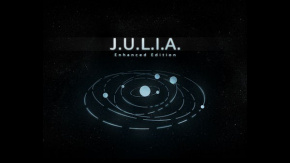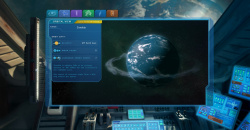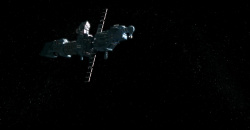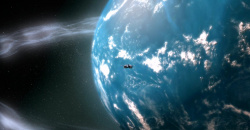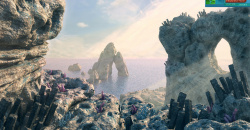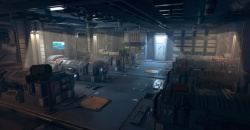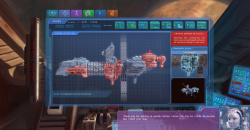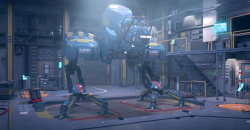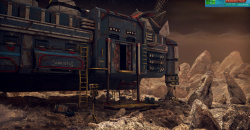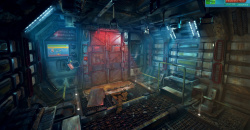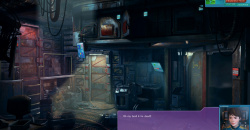Developer/Publisher: CBE Software
Release Date(s): Oct. 12, 2014
Genre(s): Point-and-click adventure
Platform(s): Windows, Mac, Linux
Language(s): English
Pricing: $19.99 USD / €19,99 EUR / £14.99 GBP
Rating: 12 (PEGI, USK), ESRB rating pending
Take Two J.U.L.I.A.: Among the Stars is the remake of J.U.L.I.A., released in early 2012 by the small Czech development studio CBE Software. What was originally planned as an “Enhanced Edition” of its somewhat disappointing predecessor ended up developing into a game all its own, thanks in large part to a successful crowdfunding campaign. With better graphics than the original game, an expanded storyline, new music and voice acting, there are more than enough reasons to give J.U.L.I.A.: Among the Stars a good look.
A rude awakening
In the year 2430, interstellar probe CX1220-Mizuka is in orbit around an unknown planet in the Salia system. Its mission: to search for extraterrestrial life. Its sole passenger, an astrobiologist by the name of Rachel Manners, is in a deep cryogenic slumber. This idyllic scene doesn’t last long, however, as a sudden meteor shower destroys important parts of the spacecraft. J.U.L.I.A., the ship’s onboard AI system, is unable to carry out the repairs alone, and thus activates the emergency program, which brings Rachel out of her stasis. Rachel awakens to the space probe beset by fires, toxic gases, and short-circuiting systems – all circumstances that an astrobiologist would rather not have to deal with, if it weren’t for the fact that the rest of the crew already landed on the planet below and lost contact with the ship some time ago. Fortunately, J.U.L.I.A. is able to help, and it doesn’t take long before the probe’s 14 malfunctioning chambers are brought under control, and you’ve solved your first simple puzzle.
The probe has been taken care of for now, but what about the crew? You attempt to find out, but due to the damage sustained by the ship, J.U.L.I.A. is experiencing an amnesia of sorts. What other choice is there but to fly down to the planet and check it out for yourself? Oh yeah, there’s an exploration robot called MOBOT, also AI-controlled, that you can send to the surface – and now it’s time to become completely immersed in this intricate and fascinating storyline…
Point and click
If “point and click: makes you think of LucasArts games, Broken Sword, or The Book of Unwritten Tales, be careful, because J.U.L.I.A.: Among the Stars interprets the genre a bit differently. The most immediately noticeable difference is definitely the lack of a real player character to speak of. Aside from an animated portrait when she’s talking to J.U.L.I.A. or MOBOT, Rachel doesn’t appear on screen. The chambers of the space probe spread out before you in a static first-person perspective that’s more reminiscent of the classic Myst than anything else.
But it’s not just in terms of perspective that J.U.L.I.A.: Among the Stars parts ways with more familiar genre conventions – the user interface offers something new as well. Several different windows fill the screen throughout the game, many advancing the plot in the form of datapad entries made by the missing crew members, others presenting the player with various puzzles or serving as command terminals. Many of these features came off as sterile in the first game, but here they work really well with the overall concept and help to create a coherent and believable atmosphere – after all, you’re on a high-tech space ship in an unfamiliar solar system. And as for text – there’s a lot of it, so if you don’t like to read, don’t say we didn’t warn you!
Like all classic point and click adventure games, J.U.L.I.A.: Among the Stars uses the mouse for its main controls. Click on an object to select the action you want from a pop-up menu – the very definition of “point and click”. Some actions cannot be performed until you fulfill certain requirements. For example, you can’t clear certain piles of dirt until you know what should be under them. This comes off as kind of forced sometimes, especially when you’ve already thought your way ahead of where you are in the game.
Luckily, the developers saw fit to include a useful hotspot feature to help you find even less conspicuous objects without having to get lost in the type of “pixel hunt” games in this genre are (in)famous for. Another extremely valuable feature is the mission log, as it’s not always immediately clear what you’re supposed to be doing, especially when secondary objectives are mixed in with the main plot thread. This means you can pretty much forget about having to use a pen and paper; that is, if your short-term memory is good enough to remember numerical passwords. Last but not least are the puzzles, especially at the beginning of the game, which steadily increase in difficulty as the game goes on. There’s a truly wide variety of puzzles, from simple combination puzzles to figuring out access codes to data pads and locked rooms, and even the circuit diagram for our friend MOBOT. They never get unfair, either, as most of the puzzles rely purely on logic or knowing how to categorize and combine items, and they all fit well into the storyline. The only complaint here is that the puzzles are sometimes not explained as clearly as they should be, and it can get frustrating if you have to first figure out what it is you’re supposed to do before you can start to figure out how to do it.
Static graphics
For the most part, the game’s graphics are a combination of static, pre-rendered backgrounds and pop-up interfaces like datapads and consoles. The occasional cut scene offers a nice change of pace, but the animation comes off as a bit wooden sometimes. However, the graphics are pretty impressive, especially when you compare them with the original game, and they do a good job of supporting the plot.
Dynamic music
Musically, J.U.L.I.A.: Among the Stars has a lot more to offer than you’d expect from its limited budget. Right in the game’s main menu you’re greeted with soft, ethnic tones that almost make you want to stay a while and listen. Unfortunately, the main menu music ends rather abruptly in a loop, but this is the only music loop that stands out in the game. In the course of the game itself, the music consists of a dynamic combination of various sound clips that result in an unobtrusive soundtrack with themes ranging from exotic, to futuristic, to mystical. Rarely does game music do such a good job of supporting the game and creating such an immersive atmosphere. So it’s no surprise to find out that one of the developers, Jan Kavan, is a professional musician.
The voice acting sort of pales in comparison to the music, which has less to do with the synchronization not being good enough (it’s actually really good), and more to do with the fact that the music is just so good. MOBOT turns out to be the real star of the game, and his voice often inadvertently comes off as a bit funny. At this time English is the only available language, even in the subtitles that accompany the spoken lines.





